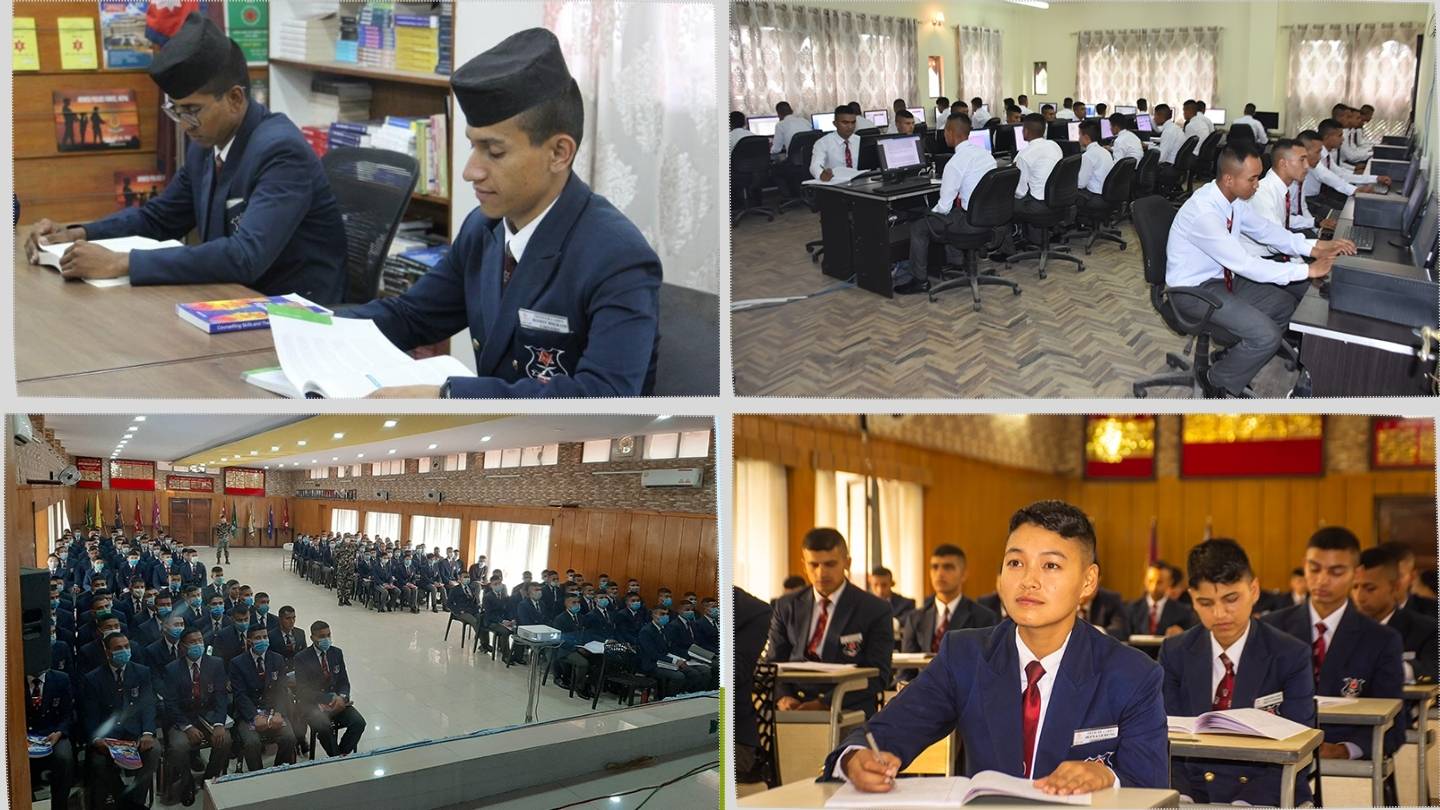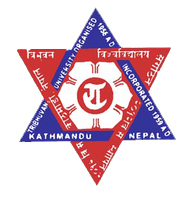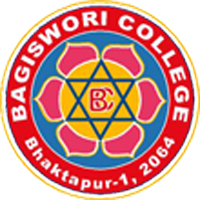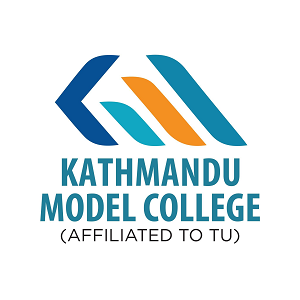Overview
Nepali Military Academy (NMA), Kharipati, Bhaktapur, is the Nepal Army’s officer-training academy that combines structured military training with a Tribhuvan University (TU) Bachelor’s Degree.
This content covers academic programs, the Officer Cadet Course, selection processes overseen by the Recruitment and Selection Directorate, campus life, facilities, and milestones. Primary terms and entities used throughout include: Nepali Military Academy, Nepal Army officer cadet training, Kharipati Bhaktapur, Tribhuvan University Bachelor’s Degree, Officer Cadet Course (36 months), JNCO Officer Cadet Course, Technical Officer Basic Course, Bachelor Officer Cadet Course (12 months), Officer Orientation Course, DGMT&D, and NMA companies (Nuwakot, Kerung, Makwanpur, Nalapani, Jitgadhi). NMA’s location in Kharipati and the integrated TU program are documented by the academy’s official pages and public records.
Overview
Nepali Military Academy (NMA) is the Nepal Army’s center for cultivating junior leaders prepared to command at platoon level. Training blends classroom study, field exercises, and structured leadership development. The academy’s academic partner is Tribhuvan University, which enables cadets to complete a four-year BA while undergoing military training.
NMA stands in Kharipati, Bhaktapur, on a 45-acre campus at an altitude conducive to year-round outdoor training. Its motto—Knowledge, Service, Leadership—captures the balance between academic learning, national service, and ethical leadership that defines the officer pathway.
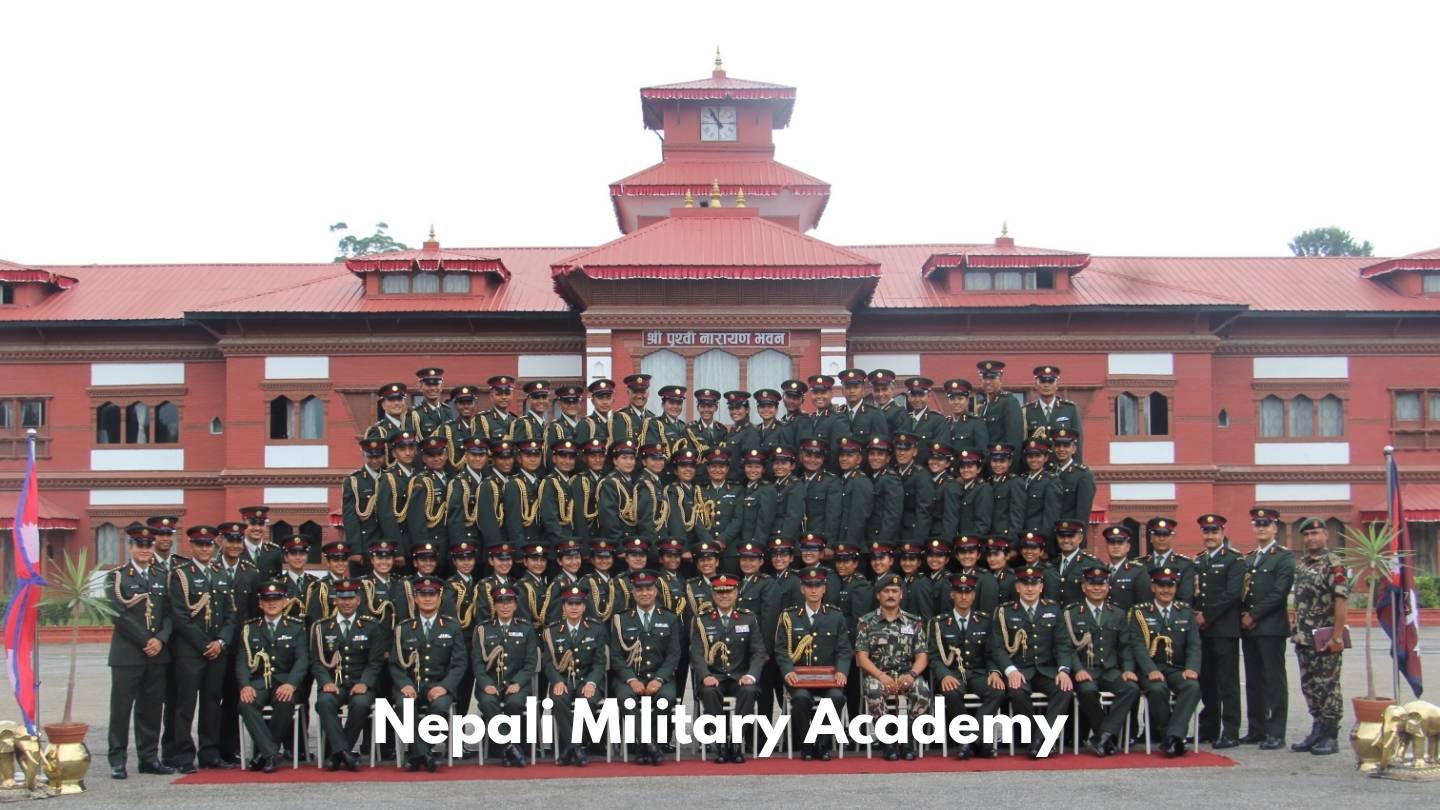
Quick Highlights
-
Institution: Nepali Military Academy (NMA), Nepal Army
-
Location: Kharipati, Bhaktapur; foothills of Nagarkot; approx. 18 km east of Kathmandu; campus area ~45 acres at ~1,350 m elevation.
-
Motto: Knowledge, Service, Leadership.
-
Governance: Directorate General of Military Training & Doctrine (DGMT&D)
-
Academic Affiliation: Tribhuvan University (TU) for an integrated Bachelor’s Degree (BA) within cadet training.
-
Programs:
-
Officer Cadet Course (36 months; integrated TU BA)
-
Bachelor Officer Cadet Course (12 months)
-
JNCO Officer Cadet Course (9 months)
-
Technical Officer Basic Course (3 months NMA phase)
-
Officer Orientation Course (3 months)
-
Army Drill Instructor Course (3 months)
-
-
Company System: Cadets organized into companies named after historic battles: Nuwakot, Kerung, Makwanpur, Nalapani, and Jitgadhi (tradition and identity).
-
Training Focus: Officer-Like-Qualities, soldiering fundamentals, leadership, tactics (conventional and unconventional), weapon training, map reading, FCBC, physical training, research-based academic study, and field exercises.
-
Evaluation: Weighted system combining theory and practice with term-wise standards and final merit ranking.
-
Milestones: Evolution of the academy under DGMT&D; rebranding to “Nepali Military Academy” in 2009; celebration marking 50 years of officer-cadet training at Kharipati in 2023; ongoing TU four-year BA delivered in compressed academic blocks during the 36-month cadet timeline.
Academic Programs Offered
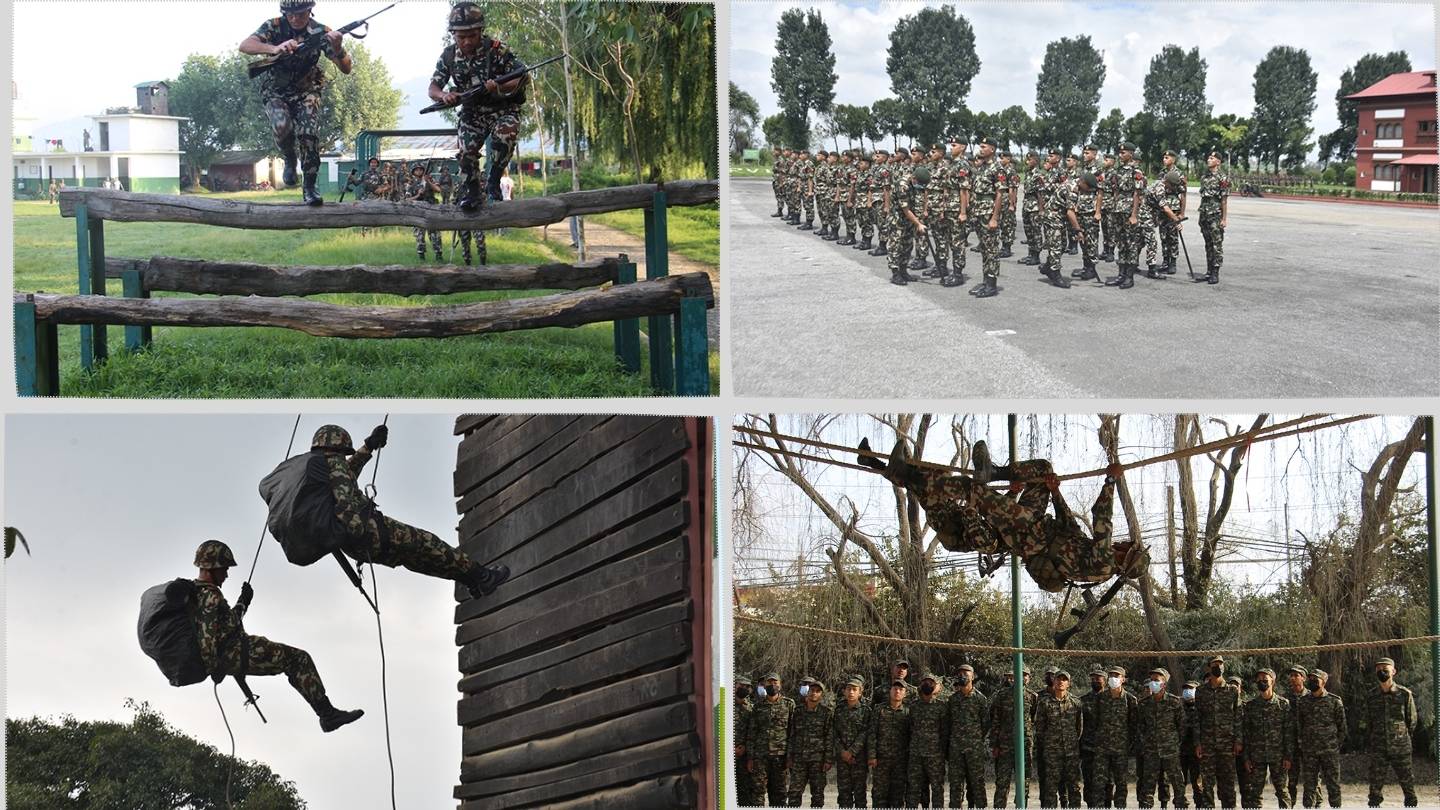
Officer Cadet Course (36 months; integrated TU BA)
Prepare Officer Cadets to lead a platoon during peace and war through progressive term-wise training combined with a TU Bachelor’s Degree program conducted within the 36-month training window. The training directive sets academic and practical standards, including ethics, discipline, and leadership.
Training objectives include:
-
Developing Officer-Like-Qualities and professional military conduct
-
Mastery of soldiering fundamentals: drill, fieldcraft, battle drill, weapon training
-
Map reading and navigation; signals, medical, logistics, and administration awareness
-
Leadership, man-management, decision-making, and communication
-
Progressive physical conditioning across all terms
-
Research-based academic learning and academic writing
-
Exposure to conventional and unconventional operations
Term concept:
-
DST Phase (approx. 8 weeks): Induction; basic drill; map reading; etiquette; attachment at Recruit Training Centre
-
Term I: Basic soldiering and military skills; drill; FCBC; weapon systems
-
Term II: Minor tactics and battle drills; drill (cane); INSAS version; field exercises
-
Term III: Conventional operations; drill (color); M16 version; planning and execution at platoon level
-
Term IV:
-
Phase 1: Unconventional operations; pistol/K2C; company-support weapons; CI environment
-
Phase 2: Leadership package; driving; adventure activities; Final Endurance Event Naulakhey Tara; Boxing Night; sports meet; commissioning parade
-
Evaluation snapshot (conceptual):
-
Theoretical and practical components with a higher weight on practical performance
-
Term-wise minimum thresholds in PT, Drill, MR/FCBC theory and practical, Tactics/Leadership written and outdoor exercises, Weapon Training, and miscellaneous knowledge areas
-
DST scores converted and added to the final result; aggregate determines merit ranking
Integrated TU Bachelor’s Degree (BA):
-
TU four-year BA is delivered in compressed academic blocks during the 36-month training period (as per TU and academy schedules). Subject clusters include English, Nepali/Alt. English, Strategic Studies (military history, strategic thought, national security, international studies), and a social science option (Political Science or Sociology) with research and academic writing components. Official academy material notes the transition from a three-year to a four-year BA beginning 2020.
Bachelor Officer Cadet Course (12 months)
Who joins: Selected Bachelor’s degree holders as designated by the Recruitment and Selection Directorate (Bharna Chhanaut Nirdeshanalaya).
Focus and sequence:
-
DST Phase (~8 weeks): Induction, basic drill, map reading, land navigation, orientation to military life
-
Term I (12 weeks): Basic soldiering, drill, weapon training, FCBC, leadership fundamentals, minor tactics
-
Term II (16 weeks): Planning and execution of major operations at platoon level in a conventional environment; exposure to signals, engineer, medical, logistics/administration
-
Term III (12 weeks): Planning and execution in an unconventional environment; junior leadership traits; Officer-Like-Qualities
Physical training runs across all phases; values include duty, courage, integrity, discipline, selfless service, and loyalty.
JNCO Officer Cadet Course (9 months)
Purpose: Prepare selected JNCOs for commissioning as 2/Lt with emphasis on leadership, discipline, motivation, and readiness to assume platoon responsibilities in peace and war.
Structure:
-
First Term (12 weeks): Includes ~5 weeks DST phase
-
Second Term (12 weeks)
-
Third Term (12 weeks)
Content focuses on soldiering, leadership, battle drills, and field exercises scaled for prior experience.
Technical Officer Basic Course (3 months NMA phase)
Purpose: Provide commissioned technical officers a common soldiering foundation and a shared understanding of other arms. The course builds leadership, military aptitude, discipline, and endurance suited to technical roles in both peace and war.
Structure:
-
DST (4 weeks)
-
First Term (4 weeks)
-
Second Term (4 weeks)
Officer Orientation Course (3 months)
Who joins: Senior JCOs (WO I, WO II, SWO) selected for commissioning.
Purpose: Develop leadership, discipline, physical fitness, and confidence to transition into officer duties; prepare for platoon-level command and administrative responsibilities.
Structure:
-
DST (2 weeks)
-
First Term (5 weeks)
-
Second Term (5 weeks)
Army Drill Instructor Course (3 months)
Scope: Specialist drill course aimed at producing instructors who maintain parade standards, ceremonial precision, and drill instruction quality across the Army.
Admission Process
Authority: Recruitment and Selection Directorate of the Nepal Army conducts officer selection for relevant entry types (Officer Cadet intake; Bachelor Officer Cadet intake, etc.). Announcements, eligibility criteria (education, age range, citizenship), and application timelines are published in official vacancy notices. Candidates should rely on those notices for definitive requirements.
Stages often include:
-
Application screening as per official call
-
Aptitude and written tests (English and Nepali language competence, general knowledge, and military-relevant subjects as notified)
-
Physical fitness assessments and medical evaluation as per Army standards
-
Interviews and final selection by the competent authority
For the Bachelor Officer Cadet intake, the Recruitment and Selection Directorate nominates eligible graduates for the 12-month training path at NMA.
International Officer Cadets: The academic branch began including international officer cadets in the BA program in 2011, subject to inter-governmental arrangements and academy policies.
Where to confirm: Follow the Nepal Army’s official channels and the NMA pages for joining instructions and TU academic details tied to cadet intakes.
Teaching Faculty and Learning Methodology
Academic and Military Wings
-
Academic Branch: TU-affiliated BA with core courses in English and Nepali/Alt. English, Strategic Studies (military history, strategic thought, national security, international relations), plus either Political Science or Sociology. Research methods and academic writing feature in advanced years.
-
Military Training: Drill, weapon training, map reading, fieldcraft and battlecraft (FCBC), minor tactics, leadership and man-management, and progressively complex operations (conventional and unconventional).
-
Leadership Development: Seminar-style instruction, tactical decision exercises, section and platoon command drills, and a dedicated leadership package in the final phase.
-
Physical Training: Progressive standards in endurance, strength, agility, and military skills aligned with term-wise thresholds.
-
Culmination Events: Final Endurance Event Naulakhey Tara, Boxing Night, sports competitions, and the commissioning parade—events that measure fitness, resilience, and bearing.
Assessment Approach
-
Blended evaluation of theory and practical performance across terms
-
Minimum pass marks in term-specific subjects (PT, Drill, MR/FCBC, Tactics/Leadership, Weapon Training)
-
DST marks converted and added to the final score; comprehensive merit list prepared by the academy in line with directives of the training directorate
Infrastructure and Learning Facilities
Campus Setting: Kharipati campus spans roughly 45 acres at about 1,350 meters above sea level. The altitude and open grounds support drill, route marches, and tactical fieldwork across seasons.
Academic and Training Resources:
-
Library and Computer Lab: For course readings, research, and assignments at allotted times
-
Signal Lab: Radiotelephony procedure training in a controlled environment
-
Multi-purpose Gym: Indoor conditioning, military fitness standards
-
Outdoor Training Areas: Parade grounds and training lanes for drill, fieldcraft, and tactical exercises
-
Ante Rooms: Common rooms with television for regulated recreational hours
-
Canteen: Non-profit canteen for training essentials and meals
-
Laundry House: Managed services for cadet kits and uniforms
-
Medical Services: On-site medical team (doctor and nursing assistant) available around the clock; referral to Military Hospital Kathmandu when needed
-
Prayer Services: Access for international officer cadets during special hours and observances
Student Life and Campus Experience
Company System and Identity: Officer Cadets are grouped into companies named after historic engagements: Nuwakot, Kerung, Makwanpur, Nalapani, and Jitgadhi. The system creates manageable training units and builds identity, teamwork, and healthy competition.
Daily Rhythm: The day is structured around drill, academics, field training, PT, inspections, mess timings, and study hours. Discipline, punctuality, and military etiquette underpin daily conduct.
Traditions and Ceremonies: Cultural programs, mess nights, parades, and ceremonial events introduce cadets to military customs and social protocol, including mess etiquette and hosting standards expected of commissioned officers.
Extracurricular Activities (ECA)
Sports and Adventure: Athletics, team sports, and adventure activities help cadets develop stamina, teamwork, and mental toughness. Boxing Night, endurance events, and inter-company competitions are key fixtures.
Cultural Exposure: Programs reflect Nepal’s diverse heritage and also provide space for international officer cadets to share their traditions during designated events.
Community and Learning: Talks by senior officers and guest speakers, unit visits, and structured debates encourage lifelong learning and professional curiosity suited to a research-informed officer career.
Scholarships and Financial Support
NMA is a service academy under the Nepal Army. Financial provisions—such as stipends, training coverage, equipment, accommodation, rations, and academic expenses—are governed by the Nepal Army’s rules and the specific terms of each intake. For international cadets, arrangements follow bilateral agreements and official invitations. Exact entitlements, bonds, or service obligations are published in official vacancy announcements and joining instructions for the relevant cohort. Applicants should rely on those documents for the latest position.
Achievements and Institutional Milestones
-
Institutional evolution: The academy’s lineage includes a formal renaming as the Military Academy in 2006 and the rebranding to Nepali Military Academy (NMA) on 14 March 2009 under DGMT&D—the training and doctrine authority of the Nepal Army.
-
Officer production: As of September 2023, academy sources report 6,261 graduates (5,057 Regular and JNCO Officer Cadets; 1,204 Technical Officers), reflecting sustained output of platoon-level leaders for the Nepal Army.
-
50-year observance at Kharipati: In September 2023 the academy marked 50 years since the start of full officer-cadet training at Kharipati, with events highlighting leadership education and training continuity.
-
Academic modernization: Transition from a 3-year to a 4-year TU BA program effective 2020, delivered in compressed academic blocks during the 36-month cadet timeline to maintain both academic depth and training tempo.
Why Choose This Institution?
-
Integrated pathway: Military training and a TU-affiliated BA run together, so cadets graduate with both a commission (upon successful completion of all requirements) and a recognized academic degree.
-
Structured leadership development: Clear term-wise progression, culminating in field leadership, endurance events, and a commissioning parade that tests standards before joining units.
-
Evidence-based instruction: Strategic Studies curriculum anchored in military history, strategy, national security, and international relations; research and academic writing embedded in the later years.
-
Training breadth: Exposure to conventional and unconventional environments, weapon systems, FCBC, navigation, and staff skills (logistics, admin, signals, medical basics).
-
Tradition and identity: Company names linked to Nepal’s military history cultivate pride, discipline, and esprit de corps.
-
Facilities and support: Campus resources—library, labs, gym, medical care, canteen, laundry, ante rooms, prayer facilities—enable learning and well-being throughout the training cycle.
-
Transparent selection: Recruitment and Selection Directorate runs competitive entries with published criteria and schedules; candidates can prepare and apply based on official notifications.
Conclusion
Nepali Military Academy provides a clear, structured route to an officer’s commission aligned with academic study through Tribhuvan University. Located in Kharipati with established facilities, a defined term system, and an identity rooted in Nepal’s military history, the academy prepares cadets for the responsibilities of platoon-level leadership.


